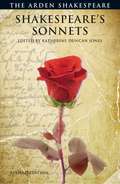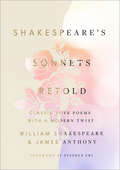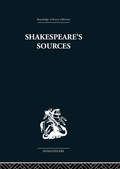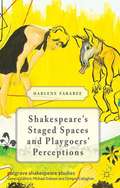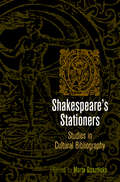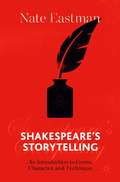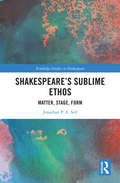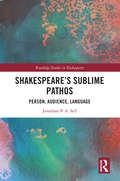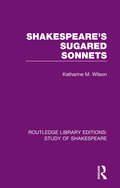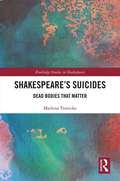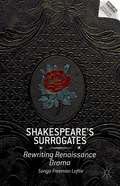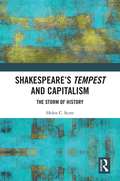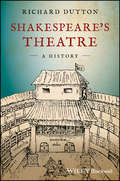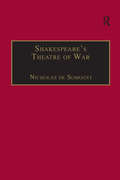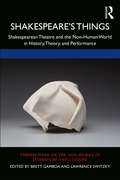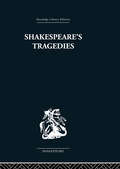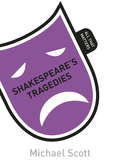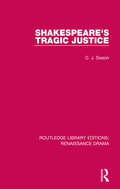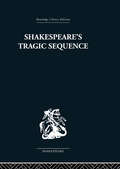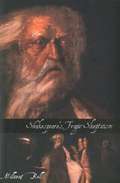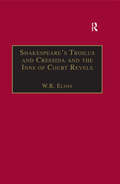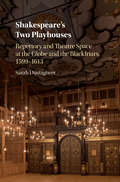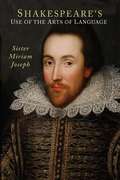- Table View
- List View
Shakespeare's Sonnets (The Arden Shakespeare, Third Series)
by Katherine Duncan-Jones William ShakespeareThe author Katherine Duncan Jones explores the issues of sexuality to be found in poems of Shakespeare, making this a truly modern edition for todays readers and students. This revised edition has been updated and corrected in the light of new scholarship and critical thinking since its first publication.
Shakespeare's Sonnets, Retold: Classic Love Poems with a Modern Twist
by William Shakespeare James Anthony Stephen FryAn enlightening and entertaining collection of the most esteemed love poems in the English canon, retold in contemporary language everyone can understand James Anthony has long enjoyed poetry with a strict adherence to beat, rhythm, and rhyming patterns, which he likens to the very best pop songs. This drew him to the rewarding 14-line structure of Shakespeare’s sonnets, yet he often found their abstract language frustratingly unintelligible. One day, out of curiosity, he rewrote Sonnet 18—Shall I compare thee to a summer’s day—line-by-line, in the strict five-beat iambic pentameter and rhyming patterns of the original, but in a contemporary language a modern reader could easily understand. The meaning and sentiment—difficult to spot, initially—came to life, revealing new intricacies in the workings of Shakespeare's heart. And so, James embarked on a full-time, year-long project to rewrite all 154 of the Bard's eternal verses creating SHAKESPEARE'S SONNETS, RETOLD. This collection of masterful reinterpretations brilliantly demystifies and breathes new life into Shakespeare's work, demonstrating the continued resonance of a playwright whose popularity remains over 400 years after his death. Now, the passion, heartbreak, deception, reconciliation, and mortality of Shakespeare’s originals can be understood by all, without the need to cross reference to an enjoyment-sapping study-guide. Coming with a foreword by Stephen Fry, this is a stunning collection of beautiful love poems made new.
Shakespeare's Sources: Comedies and Tragedies
by Kenneth MuirFirst published in 1957. This book finds discovers what the sources to Shakespeare's Comedies and Tragedies really were, considers the dramatic reasons for Shakespeare's departure from them and provides many examples of the way in which he made use of his general reading for particular scenes and speeches. Kenneth Muir shows that Shakespeare frequently uses more than one source and sometimes as many as eight.
Shakespeare’s Speculative Art
by Maurice A. HuntThis is the first book-length analysis of Shakespeare s depiction of specula (mirrors) to reveal the literal and allegorical functions of mirrors in the playwright s art and thought. Adding a new dimension to the plays Troilus and Cressida, Julius Caesar, Macbeth, Hamlet, King Henry the Fifth, Love s Labor s Lost, A Midsummer Night s Dream, and All s Well That Ends Well, Maurice A. Hunt also references mirrors in a wide range of external sources, from the Bible to demonic practices. Looking at the concept of speculation through its multiple meanings - cognitive, philosophical, hypothetical, and provisional - this original reading suggests Shakespeare as a craftsman so prescient and careful in his art that he was able to criticize the queen and a former patron with such impunity that he could still live as a gentleman.
Shakespeare's Stage Traffic
by Janet ClareShakespeare's unique status has made critics reluctant to acknowledge the extent to which some of his plays are the outcome of adaptation. In Shakespeare's Stage Traffic Janet Clare re-situates Shakespeare's dramaturgy within the flourishing and competitive theatrical trade of the late sixteenth and early seventeenth centuries. She demonstrates how Shakespeare worked with materials which had already entered the dramatic tradition, and how, in the spirit of Renaissance theory, he moulded and converted them to his own use. The book challenges the critical stance that views the Shakespeare canon as essentially self-contained, moves beyond the limitations of generic studies and argues for a more conjoined critical study of early modern plays. Each chapter focuses on specific plays and examines the networks of influence, exchange and competition which characterised stage traffic between playwrights, including Marlowe, Jonson and Fletcher. Overall, the book addresses multiple perspectives relating to authorship and text, performance and reception.
Shakespeare’s Staged Spaces and Playgoers’ Perceptions
by Darlene FarabeeThis engaging study offers fresh readings of canonical Shakespeare plays, illuminating ways stagecraft and language of movement create meaning for playgoers. The discussions engage materials from the period, present revelatory readings of Shakespeare's language, and demonstrate how these continually popular texts engage all of us in making meaning.
Shakespeare's Stationers: Studies in Cultural Bibliography (Material Texts)
by Marta StraznickyRecent studies in early modern cultural bibliography have put forth a radically new Shakespeare—a man of keen literary ambition who wrote for page as well as stage. His work thus comes to be viewed as textual property and a material object not only seen theatrically but also bought, read, collected, annotated, copied, and otherwise passed through human hands. This Shakespeare was invented in large part by the stationers—publishers, printers, and booksellers—who produced and distributed his texts in the form of books. Yet Shakespeare's stationers have not received sustained critical attention.Edited by Marta Straznicky, Shakespeare's Stationers: Studies in Cultural Bibliography shifts Shakespearean textual scholarship toward a new focus on the earliest publishers and booksellers of Shakespeare's texts. This seminal collection is the first to explore the multiple and intersecting forms of agency exercised by Shakespeare's stationers in the design, production, marketing, and dissemination of his printed works. Nine critical studies examine the ways in which commerce intersected with culture and how individual stationers engaged in a range of cultural functions and political movements through their business practices. Two appendices, cataloguing the imprints of Shakespeare's texts to 1640 and providing forty additional stationer profiles, extend the volume's reach well beyond the case studies, offering a foundation for further research.
Shakespeare's Storytelling: An Introduction to Genre, Character, and Technique
by Nate EastmanShakespeare’s Storytelling: An Introduction to Genre, Character, and Technique is a textbook focused on specific storytelling techniques and genres that Shakespeare invented or refined. Drawing on examples from popular novels, plays, and films (such as IT, Beloved, Sex and the City, The Godfather, and Fences) the book provides an overview of how Shakespearean storytelling techniques including character flaws, conflicts, symbols, and more have been adapted by later writers and used in the modern canon. Rather than taking a historicist or theoretical approach, Nate Eastman uses recognizable references and engaging language to teach the concepts and techniques most applicable to the future study of Creative Writing, English, Theater, and Film and Media. Students will be prepared to interpret Shakespeare’s plays and understand Shakespeare as the beginning of a literary tradition. A readable introduction to Shakespeare and his significance, this book is suitable for undergraduates.
Shakespeare's Sublime Ethos: Matter, Stage, Form (Routledge Studies in Shakespeare)
by Jonathan P. SellShakespeare’s Sublime Ethos: Matter, Stage, Form breaks new ground in providing a sustained, demystifying treatment of its subject and looking for answers to basic questions regarding the creation, experience, aesthetics and philosophy of Shakespearean sublimity. More specifically, it explores how Shakespeare generates a sublime mood or ethos which predisposes audiences intellectually and emotionally for the full experience of sublime pathos, explored in the companion volume, Shakespeare’s Sublime Pathos. To do so, it examines Shakespeare’s invention of sublime matter, his exploitation of the special characteristics of the Elizabethan stage, and his dramaturgical and formal simulacra of absolute space and time. In the process, it considers Shakespeare’s conception of the universe and man’s place in it and uncovers the epistemological and existential implications of key aspects of his art. As the argument unfolds, a case is made for a transhistorically baroque Shakespeare whose "bastard art" enables the dramatic restoration of an original innocence where ignorance really is bliss. Taken together, Shakespeare’s Sublime Ethos and Shakespeare’s Sublime Pathos show how Shakespearean drama integrates matter and spirit on hierarchical planes of cognition and argue that, ultimately, his is an immanent sublimity of the here-and-now enfolding a transcendence which may be imagined, simulated or evoked, but never achieved.
Shakespeare's Sublime Pathos: Person, Audience, Language (Routledge Studies in Shakespeare)
by Jonathan P. SellShakespeare’s Sublime Pathos: Person, Audience, Language breaks new ground in providing a sustained, demystifying treatment of its subject and looking for answers to basic questions regarding the creation, experience, aesthetics and philosophy of Shakespearean sublimity. More specifically, it explores how Shakespeare generates experiences of sublime pathos, for which audiences have been prepared by the sublime ethos described in the companion volume, Shakespeare’s Sublime Ethos. To do so, it examines Shakespeare’s model of mutualistic character, in which "entangled" language brokers a psychic communion between fictive persons and real-life audiences and readers. In the process, Sublime Critical platitudes regarding Shakespeare’s liberating ambiguity and invention of the human are challenged, while the sympathetic imagination is reinstated as the linchpin of the playwright’s sublime effects. As the argument develops, the Shakespearean sublime emerges as an emotional state of vulnerable exhilaration leading to an ethically uplifting openness towards others and an epistemologically bracing awareness of human unknowability. Taken together, Shakespeare’s Sublime Pathos and Shakespeare’s Sublime Ethos show how Shakespearean drama integrates matter and spirit on hierarchical planes of cognition and argue that, ultimately, his is an immanent sublimity of the here-and-now enfolding a transcendence which may be imagined, simulated or evoked, but never achieved.
Shakespeare’s Sugared Sonnets (Routledge Library Editions: Study of Shakespeare)
by Katharine M. WilsonIn the course of some research into the musical element in English poetry, Dr Wilson read the work of the Elizabethan sonneteers chronologically and was struck by a suspicion that Shakespeare’s sonnets were parodies. Later she carried out a more thorough investigation, and this book, originally published in 1974, is the product: her early impressions had been justified beyond all expectation. Her investigation involved examining the background of each of Shakespeare’s sonnets, and this in itself is a contribution to scholarship. A surprising number of them are shown to be direct parodies of particular sonnets; all of them guy the sonnet convention, and the more difficult ones are easily explained by this hypothesis. Fresh correspondences between Shakespeare and his predecessors have come to light and his relationship with them is seen to be mocking. This is demonstrated in his borrowings from Ovid also, while the opening seventeen sonnets gain point as parody of Erasmus on marriage. The book opens with a short note on the origin of the sonnet in song, chivalric love and Plato. The sonnet theme in Shakespeare’s early comedies is treated freshly and the author throws light on the plays from a new angle. In the final chapter, among other themes, the implication of dating is considered, and here too some new material is discussed. However, Dr Wilson is aiming at a wider readership than that of scholars alone. She has a view of Shakespeare as a young man catering for "young-man laughter", as she puts it, and she never loses sight of this aspect in her study. Although the academic basis is there, the presentation is not academic. Her aim is clearly to share the joke with her readers.
Shakespeare’s Suicides: Dead Bodies That Matter (Routledge Studies in Shakespeare)
by Marlena TronickeShakespeare’s Suicides: Dead Bodies That Matter is the first study in Shakespeare criticism to examine the entirety of Shakespeare’s dramatic suicides. It addresses all plays featuring suicides and near-suicides in chronological order from Titus Andronicus to Antony and Cleopatra, thus establishing that suicide becomes increasingly pronounced as a vital means of dramatic characterisation. In particular, the book approaches suicide as a gendered phenomenon. By taking into account parameters such as onstage versus offstage deaths, suicide speeches or the explicit denial of final words, as well as settings and weapons, the study scrutinises the ways in which Shakespeare appropriates the convention of suicide and subverts traditional notions of masculine versus feminine deaths. It shows to what extent a gendered approach towards suicide opens up a more nuanced understanding of the correlation between gender and Shakespeare’s genres and how, eventually, through their dramatisation of suicide the tragedies query normative gender discourse.
Shakespeare’s Surrogates
by Sonya Freeman LoftisShakespeare's Surrogates contends that the adaptation of Renaissance drama played a key role in the development of modern drama's major aesthetic movements. This book reveals the way that modern drama built itself in response to its Elizabethan past, ransacking the literary work of Shakespeare and his contemporaries for 'new' innovations in dramatic technique and content. Indeed, playwrights central to the evolution of modern and postmodern drama often returned at key moments in their writing careers to the remains of the Renaissance. Sonya Freeman Loftis argues that for playwrights such as Bernard Shaw, Bertolt Brecht, Eugene O'Neill, Samuel Beckett, Tom Stoppard, and Heiner Muller, Shakespearean appropriation was central both to the creation of their public personas and to the development of their own dramatic canons. "
Shakespeare's Tempest and Capitalism: The Storm of History
by Helen C. ScottIn this forceful study, Helen C. Scott situates The Tempest within Marxist analyses of the ‘primitive accumulation’ of capital, which she suggests help explain the play’s continued and particular resonance. The ‘storm’ of the title refers both to Shakespeare’s Tempest hurtling through time, and to Walter Benjamin’s concept of history as a succession of violent catastrophes. Scott begins with an account of the global processes of dispossession—of the peasantry and indigenous populations—accompanying the emergence of capitalism, which generated new class relationships, new understandings of human subjectivity, and new forms of oppression around race, gender, and disability. Developing a detailed reading of the play at its moment of production in the business of theatre in 1611, Scott then moves gracefully through the global reception history, showing how its central thematic concerns and figurative patterns bespeak the upheavals and dispossessions of successive stages of capitalist development. Paying particular attention to moments of social crisis, and unearthing a radical political tradition, Scott follows the play from its hostile takeover in the Restoration, through its revival by the Romantics, and consolidation and contestation in the nineteenth century. In the twentieth century transatlantic modernism generated an acutely dystopic Tempest, then during the global transformations of the 1960s postcolonial writers permanently associated it with decolonization. At century’s end the play became a vehicle for exploring intersectional oppression, and the remarkable ‘Sycorax school’ featured iconoclastic readings by writers such as Abena Busia, May Joseph, and Sylvia Wynter. Turning to both popular culture and high-profile stage productions in the twenty-first century, Scott explores the ramifications and figurative potential of Shakespeare's Tempest for global social and ecological crises today. Sensitive to the play’s original concerns and informed by recent scholarship on performance and reception history as well as disability studies, Scott’s moving analysis impels readers towards a fresh understanding of sea-change and metamorphosis as potent symbols for the literal and figurative tempests of capitalism’s old age now threatening ‘the great globe itself.’
Shakespeare's Theatre: A History
by Richard DuttonShakespeare’s Theatre: A History examines the theatre spaces used by William Shakespeare, and explores these spaces in relation to the social and political framework of the Elizabethan era. The text journeys from the performing spaces of the provincial inns, guild halls and houses of the gentry of the Bard’s early career, to the purpose-built outdoor playhouses of London, including the Globe, the Theatre, and the Curtain, and the royal courts of Elizabeth and James I. The author also discusses the players for whom Shakespeare wrote, and the positioning—or dispositioning—of audience members in relation to the stage. Widely and deeply researched, this fascinating volume is the first to draw on the most recent archaeological work on the remains of the Rose and the Globe, as well as continuing publications from the Records of Early English Drama project. The book also explores the contentious view that the ‘plot’ of The Seven Deadly Sins (part II), provides unprecedented insight into the working practices of Shakespeare’s company and includes a complete and modernized version of the ‘plot’. Throughout, the author relates the practicalities of early modern playing to the evolving systems of aristocratic patronage and royal licensing within which they developed Insightful and engaging, Shakespeare’s Theatre is ideal reading for undergraduates, postgraduates, and scholars of literature and theatre studies.
Shakespeare’s Theatre of War
by Nicholas de SomogyiThe period between 1585 (when Elizabeth formally committed her military support to the Dutch wars against Spain) and 1604 (when James at last brought it to an end) was one in which English life was preoccupied by the menace and actuality of war. The same period spans English drama’s coming of age, from Tamburlaine to Hamlet. In this thought-provoking book, Nick de Somogyi draws on a wide range of contemporary military literature (news-letters and war-treatises, maps and manuals), to demonstrate how deeply wartime experience influenced the production and reception of Elizabethan theatre. In a series of vivid parallels, the roles of soldier and actor, the setting of battlefield and stage, and the context of playhouse and muster are shown to have been rooted in the common experience of war. The local armoury served as a props department; the stage as a military lecture-hall. News from the front line has always been shrouded in the fog of war. Shakespeare’s Rumour is here seen as kindred to such equally dubious messengers as his Armado, Falstaff or Pistol; soldiers have always told tall tales, military ghost-stories that are here shown to have seeped into such narratives as The Spanish Tragedy and Henry V. This book concludes with a sustained account of Hamlet, a play which both dramatises the Elizabethan context of war-fever, and embodies in its three variant texts the war and peace that shaped its production. By affording scrutiny to each of its title’s components, Shakespeare’s Theatre of War provides a compelling argument for reassessing the drama of Shakespeare and his contemporaries within the enduring context of the military culture and wartime experience of his age.
Shakespeare’s Things: Shakespearean Theatre and the Non-Human World in History, Theory, and Performance (Perspectives on the Non-Human in Literature and Culture)
by Brett Gamboa Lawrence SwitzkyFloating daggers, enchanted handkerchiefs, supernatural storms, and moving statues have tantalized Shakespeare’s readers and audiences for centuries. The essays in Shakespeare’s Things: Shakespearean Theatre and the Non-Human World in History, Theory, and Performance renew attention to non-human influence and agency in the plays, exploring how Shakespeare anticipates new materialist thought, thing theory, and object studies while presenting accounts of intention, action, and expression that we have not yet noticed or named. By focusing on the things that populate the plays—from commodities to props, corpses to relics—they find that canonical Shakespeare, inventor of the human, gives way to a lesser-known figure, a chronicler of the ceaseless collaboration among persons, language, the stage, the object world, audiences, the weather, the earth, and the heavens.
Shakespeare's Tragedies
by G B HarrisonFirst published in 1951. G B Harrison here recognizes that Shakespeare's tragedies were intended for performance in a theatre and that the playwright's conspicuous gift among his contemporaries was a sympathy for joy and sorrow, pity and terror, and right and wrong of his people. The plays covered are: Titus Andronicus, Romeo and Juliet, Julius Caesar, Hamlet, Troilus and Cressida, Othello, King Lear, Macbeth, Antony and Cleopatra, Coriolanus and Timon of Athens.
Shakespeare's Tragedies: All That Matters (All That Matters)
by Michael ScottIn Shakespeare's Tragedies: All That Matters, Michael Scott explores and explains the secrets that have made Shakespeare's tragedies so enduring that they continue to be performed, watched and studied by millions of people every year. Professor Scott concentrates on the four great tragedies - Hamlet, King Lear, Othello and Macbeth - and builds an argument based around Shakespeare's use of language to prompt the audience's imagination and thought. This original little book, and its companion volume, Shakespeare's Comedies, will help you understand each of the plays in the context of its oeuvre and the changing concept of Shakespearean tragedy across the centuries.Appealing to both students and general readers, this book gives a fascinating introduction to Shakespeare's tragedies - and what matters most about them.
Shakespeare's Tragic Justice (Routledge Library Editions: Renaissance Drama)
by C. J. SissonThe problem of justice seems to have haunted Shakespeare as it haunted Renaissance Christendom. In this book, first published in 1963, four aspects of the problems of justice in action in Shakespeare’s great tragedies are explored. This study is based on the lifetime’s research of Elizabethan habits of mind by one of the most distinguished Shakespearean scholars, and will be of interest to students of English Literature, Drama and Performance.
Shakespeare's Tragic Sequence
by Kenneth MuirFirst published in 1972. The emphasis of this book is that each of Shakespeare's tragedies demanded its own individual form and that although certain themes run through most of the tragedies, nearly all critics refrain from the attempt to apply external rules to them. The plays are almost always concerned with one person; they end with the death of the hero; the suffering and calamity that befall him are exceptional; and the tragedies include the medieval idea of the reversal of fortune.
Shakespeare's Tragic Skepticism
by Millicent BellShakespeare's Tragic Skepticism has an ambitious aim. In writing it, I have tried to mark out a pathway across a trampled field, discussing plays more commented on over four centuries than anything else ever written except the Hebraic-Christian Bible.
Shakespeare’s Troilus and Cressida and the Inns of Court Revels
by W.R. Elton’No one of Shakespeare’s plays is harder to characterize’, said Coleridge of Troilus and Cressida. Over the centuries, generations of critics have faced the challenge of determining exactly what sort of play Shakespeare’s Troilus and Cressida is. Described by Victorian commentators as ’dark’, ’decadent’ and ’bitter’, the work has, until now, retained its designation as a ’problem play’. In this ground-breaking study, leading Shakespeare scholar, W R Elton attempts to dismantle this presumption. His research places the play in the historical context of the Inns of Court law-revels tradition. By close analysis of the text, Elton demonstrates his belief that Troilus and Cressida was written specifically for an audience of law students and lawyers and that the play manifests many elements of a law-revel, including misrule, inversion, mock rhetoric and logic, and mock trials. In so doing, he provides explanations for many of the puzzling and mysterious elements that have previously baffled critics.
Shakespeare’s Two Playhouses: Repertory and Theatre Space at the Globe and the Blackfriars, 1599–1613
by Sarah DustagheerIn what ways did playwrights like Shakespeare respond to the two urban locations of the Globe and the Blackfriars? What was the effect of their different acoustic and visual experiences on actors and audiences? What did the labels 'public' for the Globe and 'private' for the Blackfriars, actually mean in practice? Sarah Dustagheer offers the first in-depth, comparative analysis of the performance conditions of the two sites. This engaging study examines how the social, urban, sensory and historical characteristics of these playhouses affected dramatists, audiences and actors. Each chapter provides new interpretations of seminal King's Men's works written as the company began to perform in both settings, including The Alchemist, The Tempest and Henry VIII. Presenting a rich and compelling account of the two early modern theatres, the book also suggests fresh insights into recent contemporary productions at Shakespeare's Globe, London and the new Sam Wanamaker Playhouse.
Shakespeare's Use of the Arts of Language
by Sister Miriam JosephThis was the first book which presented, in a complete manner, a general theory of composition then current in Renaissance England. Its particular contribution is the reorganization of the two hundred figures of speech, distinguished by Renaissance rhetoricians, into a simple, understandable pattern basic in Aristotle's Rhetoric: grammar logos, pathos and ethos. The purpose of the book is to provide a handbook of the theory of composition then current during the English Renaissance and to show Shakespeare's use of this theory by simple illustration from his plays and poems. The book is addressed to the wide audience of teachers of English and Renaissance literature, the philologist, the Shakespearian scholar, and to students and teachers of all Romance languages.
